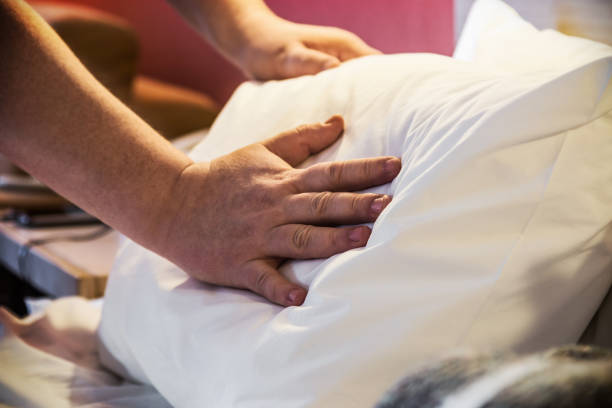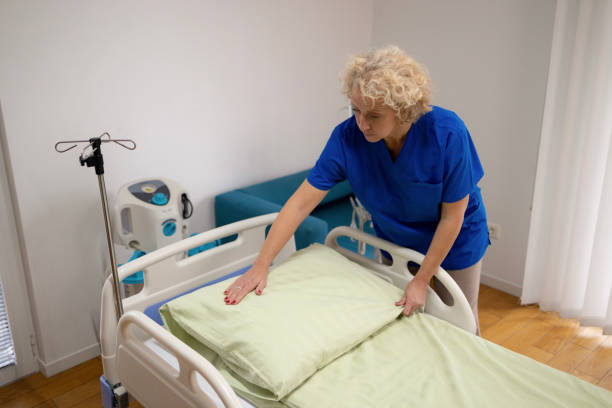Introduction

Comfortable bedding is essential for promoting restfulness and overall well-being in individuals with Parkinson's disease who want to ensure a good night's sleep. Parkinson's, a neurodegenerative disorder affecting movement and coordination, can lead to various challenges during sleep, including muscle stiffness, tremors, and difficulty finding a comfortable position.
This blog post will discuss the scientific advancements in bedding designed for Parkinson's patients. It will cover innovative materials, ergonomic design, and advanced technologies to create a supportive and comfortable sleeping experience. Learn with us as we explore how comfortable bedding can improve the quality of life for Parkinson's patients through science. Join us to uncover the secrets.
Overview of Parkinson's Disease and Its Impact on Sleep
An estimated 10 million people worldwide are affected by Parkinson's disease (PD), a chronic and progressive neurological disorder. This condition is identified by motor symptoms, including tremors, rigidity, slowed movement, and cognitive and psychological impairments. Other common symptoms of PD include sleep disturbances such as insomnia, excessive daytime sleepiness (EDS), and rapid eye movement (REM) sleep behavior disorder.
Sleep disturbances in PD can significantly impact the quality of life, with patients experiencing daytime fatigue, difficulty concentrating, and an overall decrease in functioning. Additionally, the effects of disturbed sleep patterns can make treating other symptoms of PD more difficult. As such, people with PD need to be aware of the impact of sleep disturbances and get treatment when necessary.
Various treatments are available for sleep disturbances in PD, including medications, lifestyle changes such as exercise, and cognitive-behavioral therapy (CBT). Medications may include:
-
Melatonin or dopamine agonists aid in improved sleep onset.
-
Hypnotics to help with sleep maintenance.
-
Antidepressants, antipsychotics, or anticonvulsants for REM sleep behavior disorder.
The Science Behind Comfortable Bedding for Parkinson's Patients

1. Improved Circulation:
Improved circulation of blood is essential for Parkinson's patients since it helps to reduce muscle stiffness and spasms. Bedding designed specifically for people with Parkinson's can help improve circulation by enabling independent mobility without putting excessive pressure on the joints or muscles. The clothing should allow for breathability, enabling air to flow around the body and enhancing comfort and temperature regulation.
The materials used in bedding play a significant role in helping to improve circulation. For instance, memory foam mattresses can be especially beneficial because they provide support that helps reduce body pressure points while providing sufficient cushioning and comfort. However, be aware that some memory foam mattresses can make moving to reposition more difficult because the body weight has sunk into the foam. It is advisable to trial various mattresses to find the one that best meets your mobility and comfort needs. Polyester-filled bedding and down-filled comforters are excellent choices because they provide a softer surface for the body to rest on, making it much more comfortable.
2. Temperature Regulation
Temperature regulation is very important for people with Parkinson's, as it can help reduce muscle stiffness and spasms. To regulate their body temperature effectively, Parkinson's patients should look for bedding that offers a good balance of warmth and breathability. Cotton or wool are natural materials that can offer both warmth and breathability. These materials can keep the body comfortable while allowing increased air circulation, but their relative coarseness of fibre will make moving more difficult because of friction against the bed sheet. In contrast, sleepwear made from ultra-smooth filaments with moisture-wicking properties such as performance polyesters, can also help to make moving easier, due to its lower friction against the sheet. Temperature regulation is aided through the wicking properties that help keep the garment and body dry and more comfortable.
Additionally, choosing a bed with temperature-regulating technology can help ensure the body is kept at a comfortable temperature throughout the night. Memory foam mattresses can have either an open-cell or closed-cell design. This design helps regulate temperature by enabling air to flow freely within the mattress. This helps keep the body cool during hot summer nights and warm in cold weather. Additionally, down-filled comforters are great for keeping heat trapped within, which is beneficial on cold winter nights.
Overall, with the right bedding and sleepwear, it's possible to provide a comfortable sleeping environment for Parkinson's patients, enabling them to experience improved temperature regulation, mobility, and a better night's sleep. The right combination of materials, warmth, breathability and ergonomic design is essential for creating a cozy environment that can provide relief to those experiencing the symptoms of Parkinson's. By conducting thorough research and being mindful of your needs, it is possible to discover bedding that offers warmth and comfort while providing the necessary support for ease of mobility and relief from nighttime discomforts.
3. Supportive Posture

The support of a good posture is essential for people with Parkinson's as it helps to reduce muscle stiffness and spasms. While sleeping, the body should be kept in a neutral position, meaning the spine should remain straight throughout the night and not become twisted or bent. This can be partially achieved through careful mattress selection.
Memory foam mattresses are typically the best option for providing spinal support, as they conform to the body's natural curves and provide enough cushioning and comfort that prevents too much pressure from being put on any single area. It is also possible to use pillows and mattress toppers while sleeping to maintain a neutral position for the neck. Some people may find memory foam more difficult to move on, so it is advisable to trial a few types to determine which best meets your overall needs for comfort and mobility.
A sleep positioner or body pillow can help keep the body in an ideal position to further aid posture. Body pillows and positioning devices are designed to provide extra support and cushioning while keeping the spine in alignment. This device helps reduce pressure in certain areas, such as the neck and lower back, while providing additional comfort.
Overall, finding the right combination of supportive mattresses and positioning devices can help to maintain a good posture throughout the night. This will improve sleep quality and help reduce muscle stiffness and spasms associated with Parkinson's disease. By following these recommendations, people with Parkinson's can enjoy more restful sleep, providing them the support and relief they need to cope with their condition.
4. Pressure Relief
When dealing with the symptoms of Parkinson's, pressure relief is essential for providing comfort and reducing pain. Special mattress technologies can help reduce pressure points and support the body's natural curves while sleeping. The design of memory foam mattresses makes them suitable for individuals with Parkinson's. They are made to conform to the body's shape and support the hips, shoulders, and lower back. These mattresses are also designed to reduce motion transfer between two partners in bed, which can be beneficial for couples dealing with the symptoms of Parkinson's.
Additionally, mattress toppers can help provide extra cushioning on top of a traditional mattress while keeping the body in neutral alignment. This extra cushioning helps to reduce pressure points and provides comfort for those dealing with joint pain or stiffness due to Parkinson's. Have you heard about the benefits of memory foam pillows? They can provide adequate support to your head and neck by conforming to your body's natural curves, ensuring your spine stays neutral for better alignment while you sleep.
Finding the right combination of mattress and bedding can help relieve pressure and improve sleeping comfort. This will improve sleep quality and help reduce pain and stiffness associated with Parkinson's disease. By following these recommendations, people with Parkinson's can enjoy more restful sleep, providing them the support and relief they need to cope with their condition.
5. Hygienic Materials
The right materials in the bedroom are essential for maintaining a healthy environment and controlling dust or other allergens. People with Parkinson's are especially susceptible to dust and allergens, so choosing hypoallergenic materials and easy to keep clean is important. Mattresses should be made of materials such as memory foam, latex, or wool which are naturally hypoallergenic and resistant to dust mites. To ensure proper maintenance, it's advisable to use mattress covers made from breathable fabric that can be easily washed and dried.
Bed sheets and pillowcases should also be chosen with care. Traditionally, bed sheets made of natural fibres like organic cotton, bamboo, or linen are commonly used by individuals with Parkinson's. These materials are breathable and moisture-wicking, which can help prevent overheating during the night. Additionally, these materials are also naturally hypoallergenic and resistant to dust mites. However, with these materials there is a relatively high measure of friction as the individual moves to get in or out of bed and with turning too. More effort is required to reposition with these fabrics. In contrast, using synthetic materials for their ultra-smooth fibres and as part of a non-traditional design, moving in bed is made easier – frictional resistance has been minimized and the individual can move with greater freedom of movement. These materials also have moisture-wicking features for added comfort. Considering this relatively new development, bed sheets and sleepwear can be re-categorized into a new grouping – those that hinder movement and those that help movement. The latter is an ergonomic design that addresses the work our bodies perform during the night.
Finally, choosing a duvet or comforter made of hypoallergenic materials is important. Down-filled comforters are not recommended for those with Parkinson's because they collect dust and other allergens. Instead, cotton or bamboo-filled comforters are ideal as they provide warmth without the risk of collecting dust particles.
Overall, selecting the right materials can help maintain a healthy environment in the bedroom and provide comfort for people with Parkinson's. These guidelines can help you make your bedroom environment both safe and comfortable. Hygienic materials are essential for creating an environment that can help reduce the symptoms of Parkinson's while also providing quality sleep. With the right bedding, people with Parkinson's can enjoy more restful sleep and an improved quality of life.
By understanding the science behind comfortable bedding for Parkinson's patients, individuals can rest assured that they are getting the best sleep possible to help manage their symptoms and maintain better overall health. With the right combination of supportive mattresses, breathable fabrics, ergonomic design for easier repositioning, and hygienic materials, people with Parkinson's can achieve a good night's sleep.
How Comfort Can Enhance Sleep Quality in Parkinson's Patients
Getting a good night's sleep is essential for maintaining overall health and well-being. For Parkinson's patients, however, achieving comfortable sleep can be especially challenging due to the physical conditions associated with the disease. To better understand how to create a comfortable sleeping environment for those suffering from Parkinson's, it's important to understand the science behind the disease.
Parkinson's is a progressive neurological disorder that impairs movement, with rigidity and tremors being two primary symptoms. Because of these physical impairments, Parkinson's patients may struggle to move in bed to find comfort and stay asleep for an extended period. Creating a sleep-friendly environment is crucial for better sleep.
FAQ's
What is the best bedding for Parkinson's patients?
The best bedding for Parkinson's patients is easy to move on, supportive and hypoallergenic. Memory foam, latex, organic cotton, bamboo, linen or synthetics are good choices as they are breathable and resistant to dust mites.
How do you make someone with Parkinson's more comfortable?
To make someone with Parkinson's more comfortable, it is important to create a sleeping environment that is conducive to sleep. This includes choosing the right mattress, bed sheets, pillowcases made of hypoallergenic materials, and a duvet or comforter made of breathable fabrics. It may also help to adjust the room temperature and use noise-reducing materials to create a more comfortable sleeping environment.
What is the special bed for Parkinson's patients?
There is no single type of bed designed specifically for Parkinson's patients. However, selecting the right mattress, sheet design and bedding materials, and level of support can help make sleeping more comfortable.
What helps Parkinson's patients sleep?
Certain factors can help Parkinson's patients sleep better, such as choosing the right mattress and bedding materials. Memory foam, latex, organic cotton, bamboo, linen, and synthetics are good choices as they provide hypoallergenic comfort.
How do Parkinson's patients sleep at night?
Parkinson's patients may find it difficult to sleep at night due to the physical impairments associated with the disease. Establishing a comfortable sleeping environment is crucial to alleviate the symptoms. This involves choosing appropriate bedding materials and a suitable mattress, considering ease of mobility, regulating the room temperature, using noise-reducing items, and refraining from using electronic devices before bed.
Conclusion
I hope the article has clarified how bedding can be more comfortable for people with Parkinson's disease. Proper bedding can enhance their overall well-being and quality of life. By choosing supportive mattresses, mobility-enhancing sheets and sleepwear, breathable fabrics, and hypoallergenic materials, those who have Parkinson's can achieve a better night's sleep. In addition to comfortable bedding, there are several other factors to consider for an optimal sleeping environment for those with the disease. Putting in some effort and commitment can improve your sleep and enhance your general well-being.

